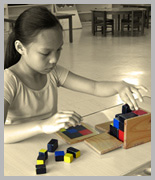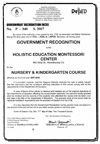The Montessori Approach
The School adheres strictly to the Montessori Method developed by Dr. Maria Montessori in the late 1800.
 DR. MARIA MONTESSORI was born in Rome , Italy in 1870 to an upper middle class family. In 1896, she became the first female doctor in Italy . She started working with children with special needs using concrete materials. Learning was not memorizing but sensing and experiencing.
DR. MARIA MONTESSORI was born in Rome , Italy in 1870 to an upper middle class family. In 1896, she became the first female doctor in Italy . She started working with children with special needs using concrete materials. Learning was not memorizing but sensing and experiencing.
She decided to use the same materials to normal children and opened her first children’s house called Casa de Bambini. And this is how the Montessori Approach was born.
 She traveled all over Europe and later around the world to share her knowledge and help children maximize their potentials. In 1929, she founded the Association Montessori Internationale (AMI) to maintain the highest standards for the education of children and to supervise the training of teachers. Dr. Maria Montessori died in 1952, but her legacy lives on.
She traveled all over Europe and later around the world to share her knowledge and help children maximize their potentials. In 1929, she founded the Association Montessori Internationale (AMI) to maintain the highest standards for the education of children and to supervise the training of teachers. Dr. Maria Montessori died in 1952, but her legacy lives on.
Basic to Dr. Montessori’s philosophy is the fact that every child has an inherent urge to learn, to master those things which he finds himself surrounded. Rather than allow this spontaneous urge to become dissipated through the lack of direction, Montessori designed a “prepared environment” in which the child’s natural desires could be directed and channeled in a deliberate manner so as to achieve an inner harmony between his desires and his intellectual and physical skills.
The Prepared Environment
The first aim of the prepared environment is, as far as it is possible, to render the growing child independent of the adult. That is, it is a place where he can do things for himself – live his own life – without the immediate help of adults. Therefore the environment is a place where the children are to be increasingly active, the teacher increasingly passive. It is a place where the child more and more directs his own life; and, in doing so, becomes conscious of his own powers. As long as he is in a state of dependency on the adult he cannot grow as he should. But living in this way, freely in a prepared environment, the child enters into vital communication with this environment, and come to love it.
This love for the environment does not exclude his love for the adult; it excludes dependence. It is true that one adult – the directress – is in a sense a part of his environment, but the function of both directress and environment is to assist the child to reach perfection through his own efforts.
*Maria Montessori, Her Life and Work, p.267


